Fabrication and materials for hard disks (drives)
Below is a short synopsis of some of the key issues in making hard drives when looked at from the view point of a material scientist. Namely, to overcome some technical challenges in making and improving hard drives, what materials are best and why?
Magnetic storage medium
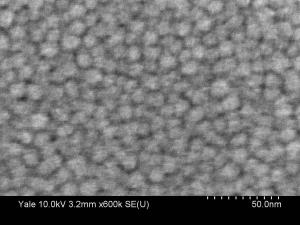 Magnetic grains (100 nm scale bar, 10 nm between ticks) |
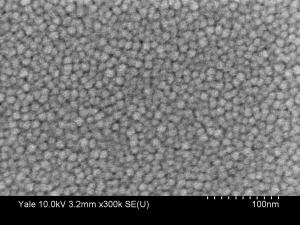 Magnetic grains (50 nm scale bar, 5 nm between ticks) |
Hard drives use magnetism to store information in a layer of magentic material below the surface of the spinning disk. If you were to look at high magnification at the surface of the platter of a typical hard disk, you would see images similar to those on the right. These images were found using a high-resolution scanning electron microscope (SEM). As you can see, the material is not uniform but made of a dense collection of very small grains whose typical diameter is around 10 nm. These images were obtained at Yale by an SEM hosted by the Yale Institute for Nanoscience and Quantum Engineering (YINQUE).
The information is stored in the magnetic layer by creating small magnetic domains in this material. Magnetic domains are regions of the material which have the same direction of magnetic moment. Magnetism in general and the formation of magnetic moments in ferromagnetic materials is fundamentally derived from electron spin (i.e. the fact that electrons act like tiny bar magnets). You can read the above links to a better understanding of the details.
The relation of the grains (shown above) to the magnetic domains is not one-to-one. Within a given grain, the magnetization is always in the same direction (i.e. a single grain doesn’t have multiple domains). But for a typical hard disk today, many grains align their magnetic moments together in the same direction to create a magnetic domain that can be hundreds of nm in size. In principle, each grain could act as an independent domain for a very dense storage of information; it is just that with present technology, the magnetic field from a single grain is so weak as to be below detection limits for present read heads (see below).
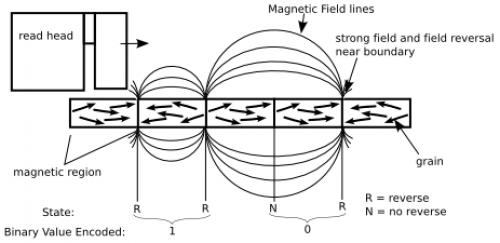 Alternating magnetic domains, the magnetic fields they create, and the read head |
The information on the hard disk is stored in the patterns of magnetization of the magnetic domains. In the diagram to the right, the domains are indicated by the regions where the magnetic moment arrows point in the same direction. (In the diagram, the magnetic moments are pointing in the plane of the platter, but the newest hardware technology uses out-of-plane moments instead; however, the principle of operation is the same.) For example a domain pointing left adjacent to one pointing right would represent a binary zero, and the opposite pattern of right-left would represent a one.
Clearly, the smaller the domains can be, the more densely the information can be stored and the higher the capacity. What can limit the storage density are many facts, among them being (a) very small domains are hard to create and read back, (b) very small domains can sometimes flip directions due to heat or noise in the environment, and (c) when very small domains are very tightly packed next to each other, their magnetic fields affect each other and one domain can flip the magnetisation of a neighboring domain over time. All these problems create errors in reading and writing the binary data — so the information is damaged or lost.
The actual materials making up the magnetic layers are typically metallic alloys. A metallic alloy is very much like a liquid solution in which various materials are dissolved: for example, when you dissolve salt in water or mix alcohol and water, the salt or alcohol gets evenly dissolved in the water throughout. In an alloy, two metals (or a metal and another material) are mixed evenly in the same manner. Everyday examples of alloys are steel (iron and a little carbon), bronze (copper and tin), and gold and silver in jewelery (each allowed with traces of different metals to give them strength). For hard drives, the magnetic alloys are typically CoPtCr (cobalt+platinum+chromium) with traces of boron or tantalum added at times to improve the stability of magnetic domains.
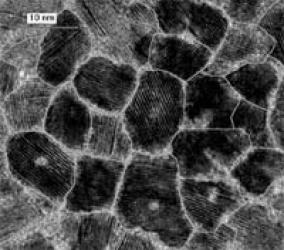 Magnetic grains |
On the right is a Transmission Electron Microscope (TEM) images of magnetic domains for hard drives from IBM research. The scale bar on the upper left is 10 nanometers (nm) so these domains are only tens tens of nanometers across! If you look carefully, you can sometimes sees bright fringes in certain domains — these fringes are actually showing the stacking of the atomic planes making up the material: once you’re on the nanoscale, atoms are not too much smaller…
Reading the data back
Given some small magnetic domains existing on a hard drive, how is that information read back and retrieved? What type of materials are best for this? As described above, the information is stored in the changing pattern of magnetization: namely, as the hard drive platter is spinning below the part of the hard drive that reads the information (the magnetic read head), the magnetic domains change direction and the encodes the information. When the magnetic domains switch direction, this means that there are two north or two south poles of the domains facing each other: this creates strong magnetic stray fields in that vicinity. So the read head must travel very close to the surface of the platter (see below for more on this) as it tries to pick up the weak magnetic fields coming from these domain switches — the fields are weak because the domains are so small, only tens of nanometers across for hard drives today!
Therefore one needs to have a material that is very sensitive to magnetic fields and can convert the existence of the stray fields into some electrical signal to be measured to recover the binary information. The basic idea is to use a material system whose resistance depends on the direction of the magnetic field. Ohm’s law tells us that V=IR, namely the voltage V across some conducting material is proportional to the current through it I times its resistance R. In a typical device like a hard drive, the voltage V is fixed as given by the power supply — so for a fixed V, the current I will change inversely as the resistance: if R is large then I is small and vice versa. If the change in R is significant, then the change in I will be easily measured. Thus a magnetoresistive material is needed which will change its resistance R in response to a magnetic field impinging on it: this will change the current I through it (at fixed voltage) and thus it will act as magnetic field to electrical current converter! So the information will come out as an electrical signal encoded in the current I (either high or low representing binary one or zero).
This is all good in theory — but are there magnetoresistive materials that can change their resistance appreciably with magnetic field? The answer is yes, and its discovery in 1988 earned Peter Grünberg and Albert Fert the Nobel prize in 2007 for discovering giant gagnetoresistive effect (GMR). The discovery of GMR was even more remarkable as it was of such technological importance that in about a single decade it was already being used in commercial products like hard drives — a fast rate for science to practical technology transfer. What they discovered is that if one makes a layered sandwich structure of two magnetic materials separated by another material, the current going between the two outer (magnetic) layers depends strongly on whether magnetic fields from the outside act on the sandwich.
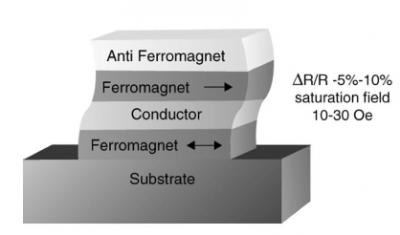 GMR read head schematic (original image from this work) GMR read head schematic (original image from this work) |
In more detail, the schematic on the right shows the layout of a GMR read head. There are two magnetic (ferromagnet in the image) layers separated by a conductor layer. The current goes from one ferromagnet to the other through the conductor. The top ferromagnetic has its magnetic direction fixed (by choosing a proper magnetic material like CoFe which doesn’t change its magnetization easily as well as the proximity to the antiferromagnetic layer above it the helps pin its magnetic direction in place due to the quantum mechanical exchange effect.) The bottom ferromagnet can easily change its direction as shown by the arrows, and is typically made of NiFe (permaloy): the NiFe can easily change its magnetization direction when an external magnetic field (from the domain switches in the substrate) is acting on it. The resistance of this setup changes by about 10% or more when the magnetic directions are aligned or anti-aligned, and that is a large enough change for engineering purposes.
But why does the resistance change? Amazingly, it does so due to quantum mechanical effects of individual electrons! Electrons have a property called spin (which makes them act as if they are spinning about an axis like a top). In magnetic materials, the electron spin axes are aligned in the same direction — and this cooperative alignment is what actually creates magnetism. During current flow, when electrons go between two ferromagnets with aligned directions, they have an easier time (i.e. lower resistance) as opposed to the opposite alignment case (i.e. higher resistance due to the mismatch of spin directions). Therefore, every time we use a hard drive, we are harnessing quantum mechanical effects on individual electrons!
High speed, low altitude reading
To make for a fast hard drive that can read data quickly, the platter must spin at a high speed — typical rates are 5,400 or more revolutions per minute. This means that the read head is moving at a relative speed of 100 km/hour (about 62 miles/hour) with respect to the platter surface… imagine reading a book that quickly!
If that is not impressive, consider that the read head must to be very close to the platter surface to be able to read the tiny magnetic domains. Close here means about 10 nm. For reference, a sheet of paper is 0.1 mm or 100 micrometers wide; a human hair is typically between 50-200 micrometers wide; we are talking of a height at least 1000 times smaller!
So, we have a read head moving at 100 km/hour only about 10 nm above it. As you can imagine, the surface of the platter must be very flat in order to avoid collisions between the platter surface and the read head, and a great deal of engineering goes into making sure the surface is very flat, that frictional forces and drag forces are under control, that the materials don’t bend under heating or cooling, etc. However, to be safe all hard drive surfaces are coated with a protective overcoat and lubricant. The overcoat is typically carbon in a diamond-like form which provides for hardness and corrosion resistance; the overcoat is only a few nm thick. Typical lubricants are flouropolyether (PFPE) which are high stable chemically and thermally; the lubricant layer is at most 1 nm thick as well.